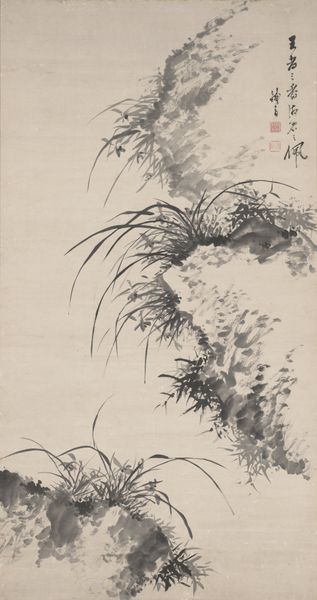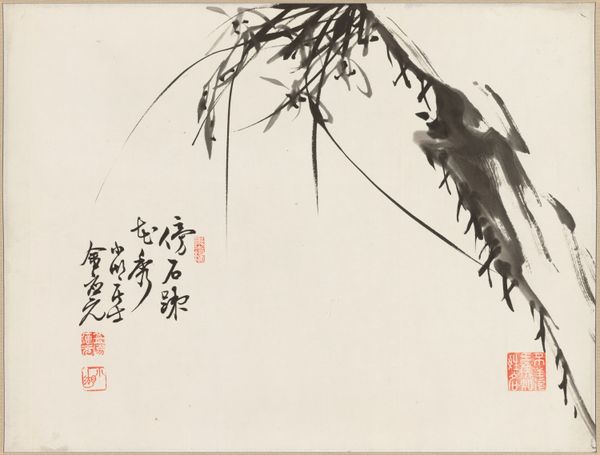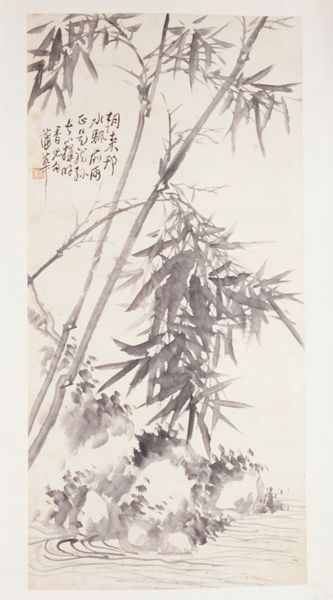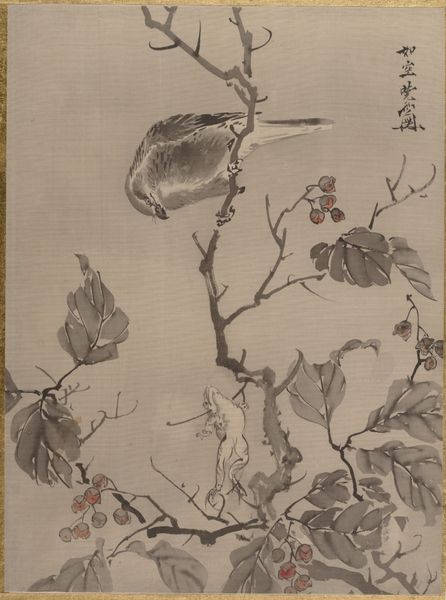
drawing, paper, ink-on-paper, hanging-scroll, ink
#
portrait
#
drawing
#
narrative-art
#
asian-art
#
paper
#
ink-on-paper
#
hanging-scroll
#
ink
Dimensions: 41 15/16 x 11 1/2 in. (106.52 x 29.21 cm) (image)79 13/16 x 19 7/8 in. (202.72 x 50.48 cm) (without roller)
Copyright: Public Domain
Curator: Take a moment to consider this hanging scroll, titled "Crippled Zhang Meets Hunchback Li," likely created in the early 17th century. It’s crafted with ink on paper. Editor: My first impression is that there is an element of caricature, almost gently humorous, about these two figures depicted. It is minimalist in its design, although its focus seems entirely based on the bodies of the two men and their setting in nature. Curator: Indeed. Cao Xi's drawing stands as a superb example of Ming dynasty ink painting, especially of figural representation. These characters are likely drawn from folklore, so it is important to keep that in mind. This would influence how viewers saw it in society. What meanings do you derive from that context? Editor: In a society often fixated on perfectibility, seeing these flawed characters celebrated – immortalized, even – could be subversive. I mean, think about it—ink on paper meant relatively wide distribution through printing, creating accessible narratives about difference. It raises the status of the common person as much as their stories. Curator: Absolutely. We should also acknowledge how this type of imagery, seemingly accessible and humorous, reinforces cultural perceptions through readily available materials and repeatable processes. This piece resides at the intersection of folk traditions, and artisanal practices shaping societal perspectives in both production and reception of artwork. Editor: Looking at how such art could impact audiences over time fascinates me. These sorts of social commentary, using recognizable figures and reproducible materials, can serve as valuable insight on the development and reflection of selfhood within society at the time. Curator: Agreed. Cao Xi’s work here challenges us to see not just the surface but the socio-cultural factors underpinning its creation and enduring relevance. Editor: It offers a rather interesting snapshot of how early seventeenth century craftsmanship and stories combined. Curator: Precisely. This work pushes us to reconsider the boundary separating fine art from common crafts.
Comments
minneapolisinstituteofart almost 2 years ago
⋮
Two lively wise men are shown here engaging in expressive conversation under a drooping pine tree. The inscription, however, adds a layer of political commentary to this work, which was executed around the time of the collapse of the increasingly corrupt Ming court, resulting in the Manchu takeover in 1644. The poem implies that the men, whose bodies are bent, have better characters (i.e., stand straighter) than those in the corrupt court. It reads: Crippled Zhang, carrying dishes of food, off to visit kin,meets hunchbacked Li along the way, andexchanges words of wisdom with him.The two men clap their hands in glee,and laugh out loud: Ha, ha!Nowhere in this world is there a manwho stands quite straight!
Join the conversation
Join millions of artists and users on Artera today and experience the ultimate creative platform.













